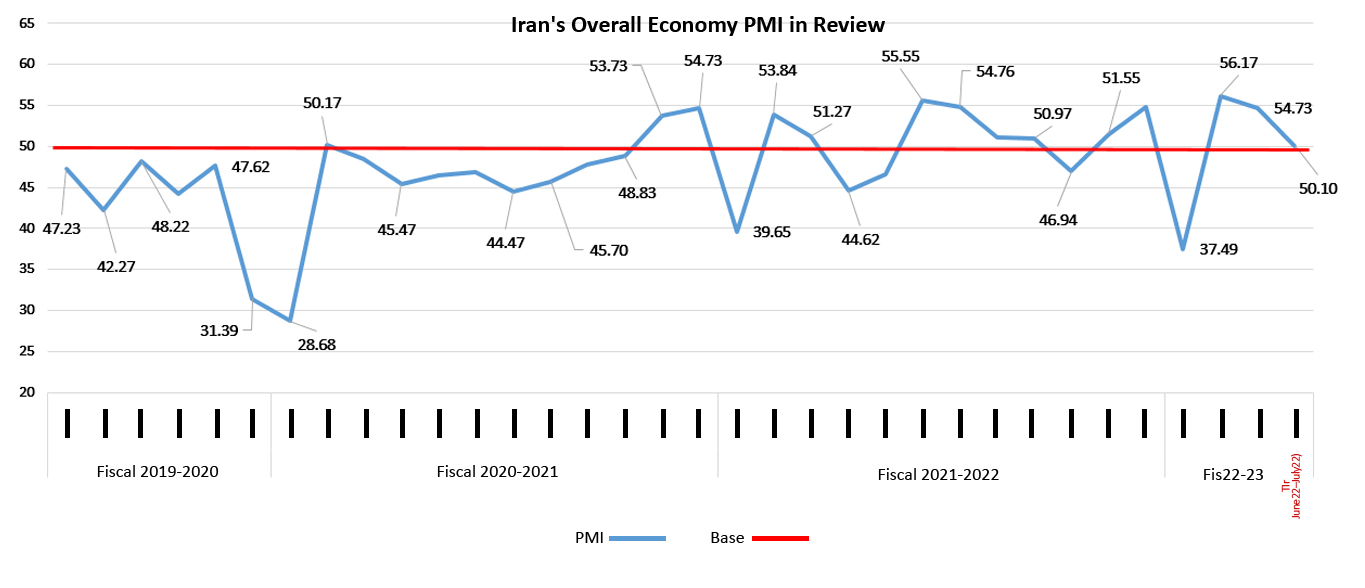Iran’s PMI shows reducing purchasing power of customers in month to July 22
Iran’s new PMI data for the fiscal month of Tir (June 22 – July 22), released by the country’s Chamber of Commerce shows that the new orders sub-index has dropped to a three-month low which is largely due to a fall in the purchasing power of customers.
According to the new PMI reading, Iran’s monthly PMI of Tir (50.10) continued to remain above the threshold but dropped from that of the preceding month.
Except for new orders and raw material inventories, all the other main sub-indexes were registered above the threshold (above 50).
The Statistics and Economic Analysis Center of Iran Chamber of Commerce, Industries, Mines and Agriculture, the sponsor and coordinator of the survey, announces the whole economy PMI data in a report every month.
The headline PMI is a number from 0 to 100, such that over 50 shows an expansion of the economy when compared with the previous month. A PMI reading under 50 indicates contraction and a reading of 50 implies no change.
PMI is an index of the prevailing direction of economic trends, aiming to provide information about business conditions to company directors, analysts and purchasing managers.

The “new orders” sub-index stood at 47.14 down from 51.90 in the previous month. The figure also registered a three-month low which was largely as a result of a recession in the agricultural, construction, and services sectors.
The “employment” sub-index also dropped for a third consecutive month to 51.17 in the month under review.
Concern about falling demand arising from reducing purchasing power of customers and high inflation led to a fall in the expectations of the businesses which also caused employments to retreat.
“Business activities” was another sub-index which dropped significantly in the Iranian calendar month of Tir. The sub-index, which stood at 59.50 a month earlier, fell in this month to settle at 50.82.
The construction sector registered the biggest recession among other major sectors.
The “product inventory” sub-index (57.10) has increased to its biggest since the beginning of the survey. The growth in this sub-index is largely due to reducing sales, and reducing the purchasing power of the customers.
The “exports of goods and services” sub-index dropped to one of its lowest in the past nine months – except for the Iranian New Year (Nowruz holidays) in late march.
|
INDEX
|
Ordibehesht1401
(Apr-May2022)
|
Khordad1401
(May-Jun2022)
|
Tir1401
(Jun-July2022)
|
|
PMI
|
56.17
|
54.73
|
50.10
|
|
business activities
|
61.37
|
59.50
|
50.82
|
|
new orders
|
55.19
|
51.90
|
47.14
|
|
suppliers’ delivery time
|
58.60
|
60.21
|
56.22
|
|
raw material inventory
|
45.34
|
47.72
|
45.91
|
|
employment
|
54.74
|
52.41
|
51.17
|
|
raw materials price
|
92.75
|
86.70
|
74.36
|
|
finished goods inventory
|
49.63
|
53.42
|
57.10
|
|
exports of goods and services
|
50.70
|
50.01
|
46.96
|
|
price of goods and services
|
70.05
|
62.89
|
62.27
|
|
consumption of energy carriers
|
62.22
|
61.84
|
56.53
|
|
sales of goods and services
|
60.08
|
58.08
|
46.32
|
|
expectations for next month economic activities
|
43.82
|
50.54
|
50.18
|